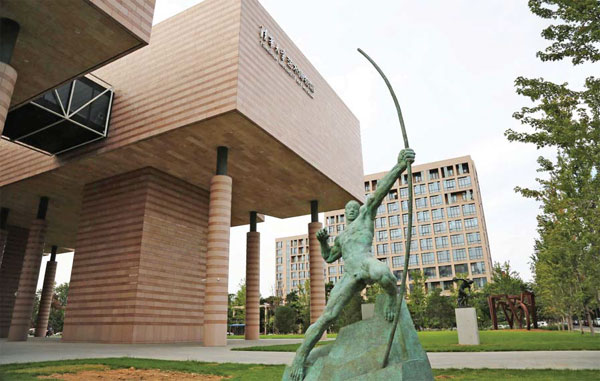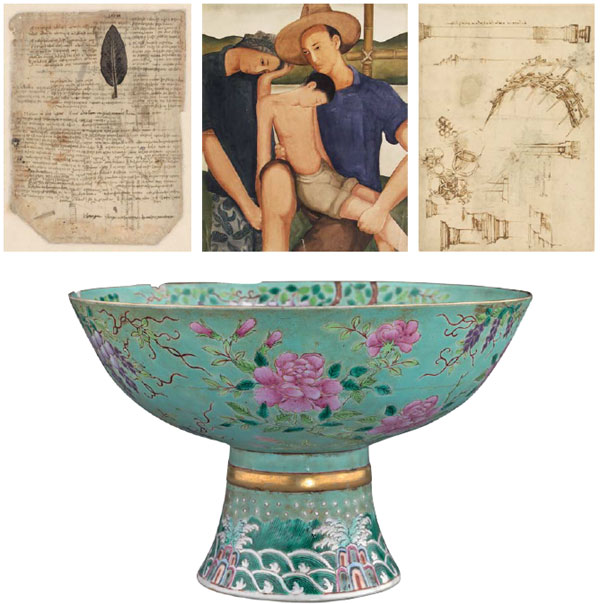Da Vinci's designs
Updated: 2016-09-16 07:11
By Lin Qi(China Daily Europe)
|
|||||||||
Tsinghua University Art Museum in Beijing opens with an exhibition featuring the Renaissance man's scientific sketches
Leonardo da Vinci is revered not only for works as the Mona Lisa and The Last Supper, but also for his work in engineering, optics, architecture, geometry and astronomy.
The scope and depth of the Renaissance man's interests is celebrated in the Codex Atlanticus, a 1,119-page, 12-volume collection of his drawings and notes on various scientific disciplines.
|
The Tsinghua University Art Museum on the campus of Tsinghua in Beijing opened on Sept 11 with 11 shows. Photos Provided to China Daily |
|
Top left and right: Pages from Codex Atlanticus are among the exhibits of Dialog with Leonardo da Vinci to mark the opening of the Tsinghua University Art Museum; Top center: A painting by contemporary Chinese artist Pang Xunqin; Above: A Qing Dynasty (1644-1911) bowl with a high stem is among the displays. |
The book is kept at the Biblioteca Ambrosiana in Milan, but 60 original pages are now on show at Tsinghua University Art Museum in Beijing.
The exhibition, Dialog with Leonardo da Vinci, is the largest exhibition on the Codex Atlanticus outside Italy. It is one of 11 shows arranged to mark the museum's official opening on Sept 11 and will run until March 19.
Along with the pages, it also has a dozen TV screens showing 3-D displays of the artist's aircraft designs and other inventions.
This is not the first time pages from the encyclopedia have been sent abroad. An earlier exhibition in Singapore featured 26 pages, while an event in Japan had 20 pages, according to Yang Dongjiang, deputy director of Tsinghua University Art Museum.
Designed by Swiss architect Mario Botta, the Beijing museum covers 5,000 square meters in the east corner of the Tsinghua University campus, making it the biggest college museum in China.
Previously, the university, founded in 1911, had a room to exhibit archaeological relics, which was opened in 1926. It was not until 1999 when the college was merged with the Central Academy of Arts and Design that a museum was proposed to house the academy's collection of fine art and antiques, which it had been assembling since 1956.
The plan received a boost in 2013 when Huang Rulun, a real estate tycoon, donated 200 million yuan ($29.9 million; 26.6 million euros) to the project.
The museum has more than 13,000 Chinese paintings, calligraphy works, textiles, porcelain pieces, bronze ware, Ming Dynasty (1368-1644) furniture and other works of art, mainly from the academy's collection and public donations.
Feng Yuan, director of the museum, describes the building's architecture as like a "palace" and says one of his goals is to ensure it remains attractive to visitors in the long run.
Speaking at media event in August, Feng, who ran the National Art Museum of China from 2004 to 2005, adds that many museums gradually lose visitors because they do not rotate their displays and lack sustainable financial support or employees experienced in museum management.
"Of course, we can't rival the Palace Museum (commonly known as the Forbidden City) or the Capital Museum in terms of collections," he says, "but we can exchange items with them."
Tsinghua University Art Museum's upcoming exhibitions will feature bronze ware from the Shang (c.16th century-11th century BC) and Zhou (c.11th century-256 BC) dynasties on loan from the National Museum of China, and paintings from the National Art Museum.
Feng says the new museum is also reaching out to college museums abroad to arrange academic cooperation and exhibitions.
"The museum should not only be an alternative classroom for students, but must also be a landmark in Beijing that people from across the country come and visit," he adds.
To this end, he says, the museum will display a variety of artwork - from ancient to modern, from home and abroad - to engage a varied audience.
As for other events marking the official opening, there will be an exhibition of multimedia installations in which international artists use digital technology to create visual effects. An area will also be devoted to contemporary art.
The museum's academic committee comprises curators, professors and artists, including Chen Lyusheng, deputy director of the National Museum of China, and Xu Bing, a professor at the Central Academy of Fine Arts.
Despite the buzz surrounding the Tsinghua University Art Museum, such museums are not a common sight in China.
The only comparable institution is Peking University's Museum of Art and Archaeology, which was named after its sponsor, Arthur M. Sackler, an American entrepreneur and philanthropist. It has a collection of drawings and prints by Western masters such as Raphael and Picasso donated by visiting US professor Donald Stone.
"Every major university in the US has an art museum. ... Students can just go over, enjoy the beautiful art and then go back to their studies," Stone says.
Things could be going that way in China, too.
Last year saw the opening of the Wanlin Art Museum at Wuhan University in the central province of Hubei.
The museum was set up thanks to Chen Dongsheng, president of Taikang Life Insurance Corp and China Guardian Auctions, who donated 120 million yuan for the project.
linqi@chinadaily.com.cn
(China Daily European Weekly 09/16/2016 page19)
Today's Top News
UK gives Hinkley Point nuclear power green light
Hillary Clinton remains healthy: doctor
UK confirms Hinkley project with 'new agreement'
Despite big deals, data shows less M&As after Brexit
New plan for grammar schools welcomed by Chinese
Moscow denies involvement in hacker attacks on WADA
EU should stay strong, stable and united: Tusk
Cameron to quit as MP; by-election triggered
Hot Topics
Lunar probe , China growth forecasts, Emission rules get tougher, China seen through 'colored lens', International board,
Editor's Picks

|

|

|

|

|

|









